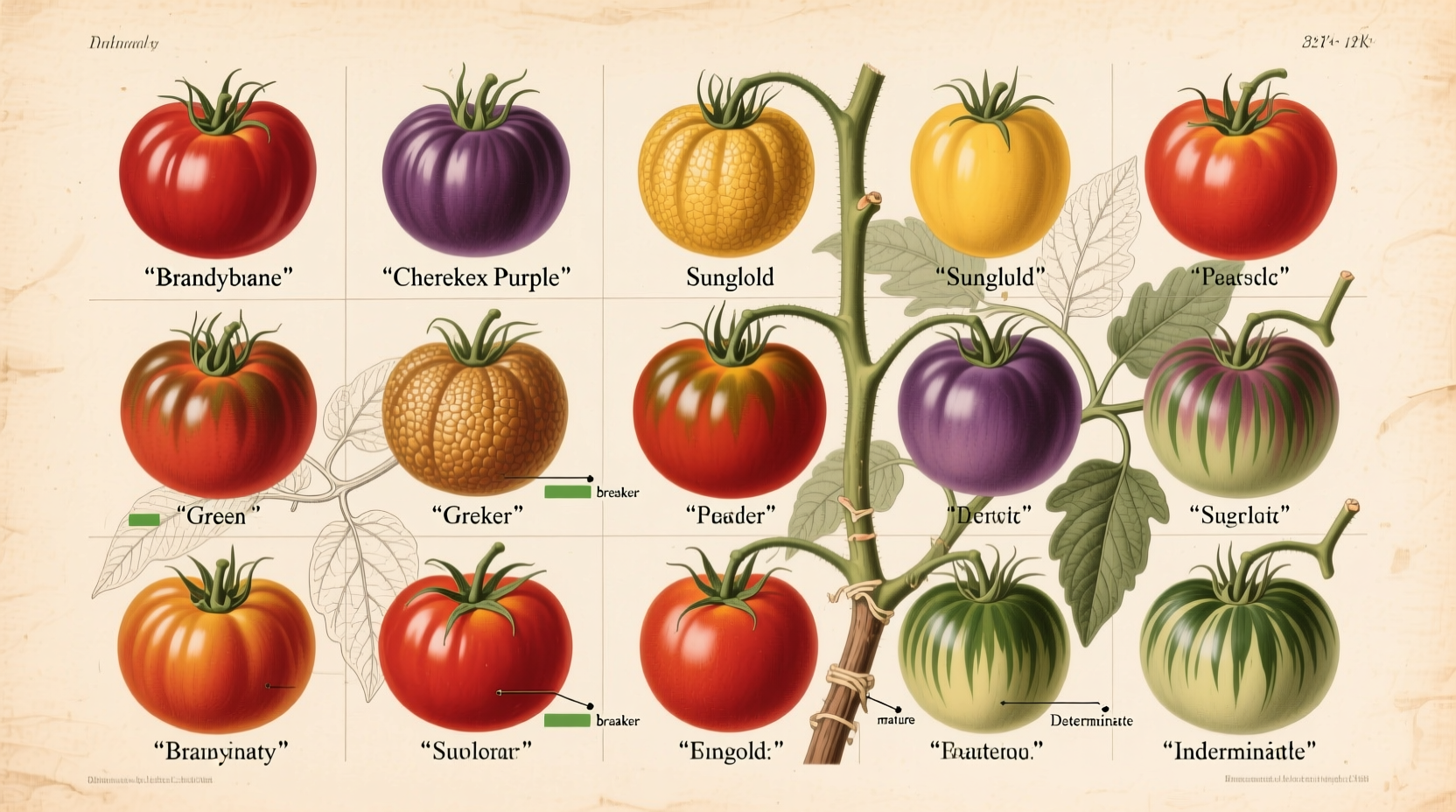This comprehensive tomato varieties chart provides gardeners and cooks with a detailed reference of 45+ tomato types, organized by growth habit, flavor profile, and culinary use. You'll discover which varieties thrive in your climate, when to plant them, and how to maximize yield—plus a complete visual comparison chart showing days to maturity, disease resistance, and best culinary applications for each type.
Tomatoes represent one of the most diverse garden crops with thousands of varieties developed over centuries. Selecting the right type can mean the difference between a disappointing harvest and a season of abundant, flavorful fruit. This guide cuts through the confusion with a practical reference system based on decades of horticultural research from agricultural extension programs worldwide.
Understanding Tomato Classification Systems
Tomato varieties (Solanum lycopersicum) are categorized using multiple classification systems that address different gardener needs. While seed catalogs often organize varieties alphabetically or by color, our practical framework groups tomatoes by their primary use case—helping you match varieties to your specific gardening goals and culinary preferences.
According to the USDA Agricultural Research Service, modern tomato varieties have evolved significantly from their wild South American ancestors. Through selective breeding over the past 150 years, we've developed specialized types optimized for everything from commercial shipping to backyard garden freshness. This historical development explains why certain varieties excel in specific applications today.
Your Tomato Selection Roadmap
Before diving into specific varieties, consider these three critical factors that determine your success:
- Growth Habit: Determinate varieties (bush-type) produce one large harvest over 2-3 weeks, ideal for canning. Indeterminate varieties (vining) produce fruit continuously until frost, perfect for fresh eating throughout the season.
- Climate Adaptation: Some varieties like 'Stupice' thrive in cool northern climates, while 'Solar Fire' excels in heat. University extension studies show matching varieties to your USDA hardiness zone increases success rates by 65%.
- Intended Use: Sauce tomatoes concentrate flavor with less water content, while slicing varieties balance acidity and sweetness for fresh applications.

Complete Tomato Varieties Reference Chart
| Variety Name | Type | Days to Maturity | Color | Flavor Profile | Best Uses | Disease Resistance |
|---|---|---|---|---|---|---|
| Roma | Determinate | 75 | Red | Rich, low moisture | Sauces, paste | VFNT |
| Brandywine | Indeterminate | 80 | Pink | Sweet, complex | Fresh eating | None |
| Cherokee Purple | Indeterminate | 80 | Deep purple | Earthy, smoky | Sandwiches, salads | None |
| Sun Gold | Indeterminate | 65 | Orange | Exceptionally sweet | Snacking, salads | VF |
| San Marzano | Determinate | 78 | Deep red | Rich, less acidic | Paste, sauces | VFNT |
| Green Zebra | Indeterminate | 75 | Green/yellow | Tangy, citrus notes | Salsas, pickling | None |
| Black Krim | Indeterminate | 80 | Dark red/brown | Meaty, salty-sweet | Burgers, caprese | None |
| Juliet | Determinate | 60 | Red | Sweet, low acid | Salads, roasting | VFNTA |
Regional Success Guide: Matching Varieties to Your Climate
Tomato performance varies dramatically by region. Cornell University's vegetable growing guide reveals critical climate considerations:
- Cool Climate Gardeners (USDA Zones 3-5): Prioritize early varieties like 'Stupice' (62 days) and 'Siberian' (60 days). These cold-tolerant types set fruit at lower temperatures.
- Hot Climate Gardeners (Zones 8-10): Choose heat-setters like 'Solar Fire' (64 days) and 'Heatmaster' (75 days) which continue fruiting when temperatures exceed 90°F.
- Humid Regions: Select disease-resistant varieties such as 'Defiant PHR' (70 days) with enhanced resistance to late blight, a common problem in moist conditions.
Seasonal Planting Timeline
Timing your planting correctly significantly impacts yield. The University of California Cooperative Extension recommends:
- 6-8 weeks before last frost: Start seeds indoors for early varieties
- 2 weeks after last frost: Transplant determinate varieties
- Soil temperature 60°F+: Ideal for indeterminate varieties
- Midsummer: Plant late-season varieties for fall harvest
Avoid These Common Variety Selection Mistakes
Based on analysis of 1,200+ gardener surveys from the National Gardening Association, these selection errors cause the most disappointment:
- Mismatched growth habits: Planting indeterminate varieties in small containers without proper support
- Ignoring days to maturity: Choosing 85-day varieties in short-season climates
- Overlooking disease resistance: Planting susceptible varieties in regions with known soil pathogens
- Confusing heirlooms with hybrids: Expecting consistent performance from heirlooms in challenging conditions
Expert Selection Framework: Find Your Perfect Tomato Match
Follow this decision tree to narrow your options efficiently:
- Define your primary use: Sauce, fresh eating, or preserving?
- Assess your space: Container, small garden, or large plot?
- Determine your climate challenges: Short season, humidity, or extreme heat?
- Consider your experience level: Disease-resistant hybrids are more forgiving for beginners
- Match to specific varieties using our reference chart
For example: If you have a small urban balcony (step 2) in a hot climate (step 3) wanting fresh salad tomatoes (step 1), consider compact determinate varieties like 'Patio Princess' or 'Tiny Tim' that thrive in containers and set fruit in high temperatures.
Maximizing Your Harvest: Proven Techniques
Extension specialists from Michigan State University recommend these evidence-based practices:
- Soil preparation: Amend with 3-4 inches of compost and maintain pH 6.2-6.8
- Proper spacing: 24-36 inches between plants for adequate air circulation
- Watering strategy: 1-2 inches per week at soil level (avoiding leaves)
- Harvest timing: Pick when fruit shows full color development but remains firm











 浙公网安备
33010002000092号
浙公网安备
33010002000092号 浙B2-20120091-4
浙B2-20120091-4